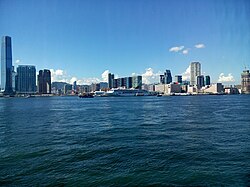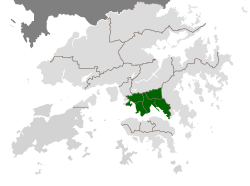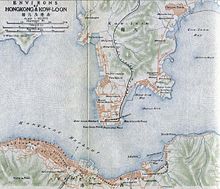Kowloon
Kowloon .mw-parser-output .nobold{font-weight:normal} 九龍 | |
|---|---|
 Kowloon as viewed from Hong Kong Island | |
| Nickname(s): Dragon City | |
 Location within Hong Kong | |
| City | Kowloon |
| Area | |
| • Land | 67 km2 (26 sq mi) |
| Population (2011) | |
| • Total | 2,108,419 (2.1 million) |
| • Density | 43,033/km2 (111,450/sq mi) |
| Time zone | UTC+8 (Hong Kong Time) |
| Kowloon | |||||||||||||||||||||
| Traditional Chinese | 九龍 | ||||||||||||||||||||
|---|---|---|---|---|---|---|---|---|---|---|---|---|---|---|---|---|---|---|---|---|---|
| Simplified Chinese | 九龙 | ||||||||||||||||||||
Cantonese Yale | Gáulùhng | ||||||||||||||||||||
| Literal meaning | "Nine Dragons" | ||||||||||||||||||||
| |||||||||||||||||||||
Kowloon (/ˌkaʊˈluːn/; Chinese: 九龍; Cantonese Yale: Gáulùhng) is an urban area in Hong Kong comprising the Kowloon Peninsula and New Kowloon. It is bordered by the Lei Yue Mun strait to the east, Mei Foo Sun Chuen and Stonecutter's Island to the west, a mountain range, including Tate's Cairn and Lion Rock to the north, and Victoria Harbour to the south. With a population of 2,019,533 (2 million) and a population density of 43,033/km2 in 2006, it is the most populous urban area in Hong Kong. The peninsula's area is approximately 47 km2 (18 sq mi).
Contents
1 History
2 Demographics
3 Localities
3.1 Administration
3.2 Politics
4 Education
4.1 Primary education
4.2 Secondary education
4.3 Tertiary education
5 Gallery
6 References
7 External links
History

Kowloon c. 1868, depicting the Qing-era Kowloon Walled City and Lion Rock (in the background)

Map of Kowloon in 1915

Hong Kong's old airport, Kai Tak, was located in Kowloon.
The name Kowloon stems from the term Nine Dragons, alluding to eight mountains and a Chinese emperor: Kowloon Peak, Tung Shan, Tate's Cairn, Temple Hill, Unicorn Ridge, Lion Rock, Beacon Hill, Crow's Nest and Emperor Bing of Song.[1]
The part of Kowloon south of Boundary Street, together with Stonecutters Island, was ceded by Qing China to the United Kingdom under the Convention of Peking of 1860. For many years the area remained largely undeveloped, used by the British mainly for tiger-hunting expeditions.[2]
The part of Kowloon north of Boundary Street (New Kowloon) was leased by the British as part of the New Territories under the 1898 Second Convention of Peking for 99 years. Within New Kowloon is Kowloon City, an area of Hong Kong where the Kowloon Walled City used to be located. The Kowloon Walled City itself was demolished in 1993. The same area was called Guanfuchang (官富場) during the Song dynasty (960–1279). "New Kowloon" has remained part of the New Territories.
Statutorily, "Kowloon" is only the area south of Boundary Street and Stonecutters Island, but in common use, New Kowloon is not regarded as part of the New Territories but as an integral part of the Kowloon urban area whether north or south of Boundary Street.
Large-scale development of Kowloon began in the early-20th century, with the construction of the Kowloon-Canton Railway and the Kowloon Wharf, but because of Kowloon's close proximity to Kai Tak Airport, building construction was limited by flight paths. As a result, compared to Hong Kong Island, Kowloon has a much lower skyline.[1] After World War II, Kowloon became extremely congested when slums for refugees from the newly established China gave way to public housing estates, mixed with private residential, commercial and industrial areas.
The area of reclaimed land known as West Kowloon was once home to a dockyard for the Royal Navy.
A 13-foot high stone wall was built in 1847 around Kowloon. The 1911 census recorded a population of 7,306, with most being Hakka.[3] The invasion of China by Japan in 1937 caused the population of Kowloon to explode. Between 1937 and 1939, 750,000 refugees arrived in Kowloon and nearby areas, with many being homeless.[4]
Demographics
As of 2011[update], 2,108,419 people lived in Kowloon.[5]
94.2% of Kowloon's residents are of Cantonese ethnicity. The largest ethnic minority groups are Indonesians (1.8%), Filipinos (1.5%), Indians (0.5%), Nepalese (0.4%), and Whites (0.3%). [5] 86% of Kowloon's residents use Cantonese as their usual language, while 2.3% use English and 1.2% use Mandarin.[5]
Localities
Kowloon comprises the following localities of Hong Kong:
- Tsim Sha Tsui
- Kwun Chung
- Yau Ma Tei
- Mong Kok
- Prince Edward
- West Kowloon
- Tai Kok Tsui
- Sham Shui Po
- Cheung Sha Wan
- Lai Chi Kok
- Shek Kip Mei
- Kowloon Tong
- Kowloon City
- Kai Tak
- To Kwa Wan
- Ma Tau Wai
- Hung Hom
- Ho Man Tin
- Wong Tai Sin
- San Po Kong
- Hammer Hill
- Ngau Chi Wan
- Tsz Wan Shan
- Diamond Hill
- Kowloon Bay
- Ngau Tau Kok
- Kwun Tong
- Sau Mau Ping
- Lam Tin
- Yau Tong
- Cha Kwo Ling
- Lei Yue Mun
Administration
Kowloon comprises the following districts:
- Kowloon City
- Kwun Tong
- Sham Shui Po
- Wong Tai Sin
- Yau Tsim Mong
Politics
Kowloon covers two geographical constituencies for the Legislative Council of Hong Kong:
Kowloon East includes Wong Tai Sin and Kwun Tong.
Kowloon West includes Yau Tsim Mong, Sham Shui Po and Kowloon City.
Education

The Hong Kong Polytechnic University in Hung Hom

King George V School, Homantin
Primary education
Secondary education
- The Church of Christ in China Ming Yin College
- King George V School
Tertiary education
- City University of Hong Kong
- Hong Kong Polytechnic University
- Hong Kong Baptist University
- Open University of Hong Kong
- Tung Wah College
- Hong Kong Nang Yan College of Higher Education
- Gratia Christian College
Gallery

Centenary Garden Fountain, Tsim Sha Tsui
Maze Garden, Kowloon Park, Tsim Sha Tsui

An Air France Boeing 747 passing above Kowloon, prior to landing at the old airport more than 20 years ago.

Star Ferry Pier, with the Hong Kong Cultural Centre and Tsim Sha Tsui Clock Tower in the background.

Kowloon Masjid
References
^ ab Fallon, Steve. (2006) Hong Kong and Macau. Lonely Planet Publishing. .mw-parser-output cite.citation{font-style:inherit}.mw-parser-output q{quotes:"""""""'""'"}.mw-parser-output code.cs1-code{color:inherit;background:inherit;border:inherit;padding:inherit}.mw-parser-output .cs1-lock-free a{background:url("//upload.wikimedia.org/wikipedia/commons/thumb/6/65/Lock-green.svg/9px-Lock-green.svg.png")no-repeat;background-position:right .1em center}.mw-parser-output .cs1-lock-limited a,.mw-parser-output .cs1-lock-registration a{background:url("//upload.wikimedia.org/wikipedia/commons/thumb/d/d6/Lock-gray-alt-2.svg/9px-Lock-gray-alt-2.svg.png")no-repeat;background-position:right .1em center}.mw-parser-output .cs1-lock-subscription a{background:url("//upload.wikimedia.org/wikipedia/commons/thumb/a/aa/Lock-red-alt-2.svg/9px-Lock-red-alt-2.svg.png")no-repeat;background-position:right .1em center}.mw-parser-output .cs1-subscription,.mw-parser-output .cs1-registration{color:#555}.mw-parser-output .cs1-subscription span,.mw-parser-output .cs1-registration span{border-bottom:1px dotted;cursor:help}.mw-parser-output .cs1-hidden-error{display:none;font-size:100%}.mw-parser-output .cs1-visible-error{font-size:100%}.mw-parser-output .cs1-subscription,.mw-parser-output .cs1-registration,.mw-parser-output .cs1-format{font-size:95%}.mw-parser-output .cs1-kern-left,.mw-parser-output .cs1-kern-wl-left{padding-left:0.2em}.mw-parser-output .cs1-kern-right,.mw-parser-output .cs1-kern-wl-right{padding-right:0.2em}
ISBN 981-258-246-0
^ 10,000 Chinese Numbers. Lulu.com. p. 207. ISBN 9780557006212. Archived from the original on 23 August 2016.
^ James Hayes, The Hong Kong Region 1850–1911. Hong Kong, 2012.[ISBN missing]
^ "Hong Kong 2003 – History". www.yearbook.gov.hk. Archived from the original on 26 September 2011. Retrieved 28 April 2018.
^ abc District Profiles, Hong Kong Census, 2011, archived from the original on 27 September 2013, retrieved 27 September 2013
External links
| Wikivoyage has a travel guide for Kowloon. |
 Media related to Kowloon at Wikimedia Commons
Media related to Kowloon at Wikimedia Commons
 Media related to Kowloon West at Wikimedia Commons
Media related to Kowloon West at Wikimedia Commons
Coordinates: 22°19′N 114°11′E / 22.317°N 114.183°E / 22.317; 114.183





